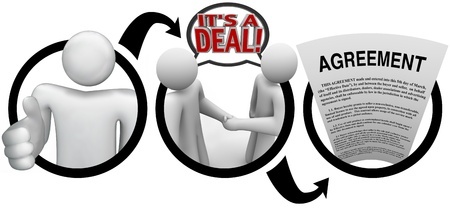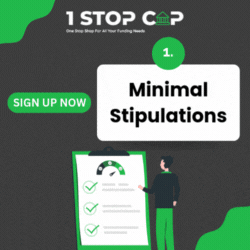sales
Motivating Your Sales Force – Tips From the Floor
August 30, 2016
Fancy steak dinners, electronic devices and cold hard cash are just some of the ways ISOs and funders these days are motivating sales reps to bring in business.
Although it’s largely a field for self-starters, many companies find that even small tokens of appreciation do wonders to increase rep productivity. “Waving a carrot in front of your reps can make a massive difference,” says Zachary Ramirez, branch manager of the Costa Mesa, California branch of World Business Lenders, an ISO and a lender.
When it comes to motivating sales reps, every company does things slightly differently. Some have more established incentive programs, while others are more ad hoc, depending on how the day, week or month is shaping up. The common goal of all the programs, however, is to give a little something to get something greater in return.
Ramirez remembers one sales rep who won a trip to Las Vegas and then continued to be the top rep for three months running. “Those types of rewards can keep a sales team motivated, hungry and excited,” he says.
From time to time, Ramirez offers rewards such as a small cash bonus if a rep meets certain metrics like getting three submissions in a day or multiple fundings in a week. In addition, whenever his reps, who are all hourly employees, hit key performance indicators, Ramirez rewards them with a poker chip. After they accumulate enough, they can trade in their chips for various prizes. Twenty-five poker chips might be worth a flat-screen TV and 50 chips could be an expense-paid trip to Las Vegas, for example.
When it comes to motivation, it’s important to incentivize the correct behavior, Ramirez says, noting that in his earlier years running an ISO, he used to reward reps based on the number of calls they made in a day rather than applications, approvals or fundings.
The latter represent a much more serious commitment and are worth motivating for as opposed to simply making a phone call, where the outcome is uncertain. “Even if they make as many as 500 phone calls in a day, it’s irrelevant if they are not moving the transactions forward by getting applications and bank statements,” he says.
It’s also very important to have clear-cut expectations; reps need to know the consequences of not performing, Ramirez says. Most top salespeople won’t need the stick. But it’s still necessary for them to know the policies, he says.
THE POWER OF SELF-ORIGINATION
One major way United Capital Source incentivizes its 15-person sales force is by self-originating leads. It provides its reps—who are all W2 employees—with merchants that are actively expecting phone calls as opposed to handing them a laundry list of names to pitch which may or may not pan out. It costs more for United Capital to do this, but it works well for the company and for its sales force, says Jared Weitz, chief executive of the New York-based alternative-finance brokerage.
“It enables us to put our guys in a position where they are growing with the company and the company is growing as well,” he says.
In addition, United Capital has an aggressive pay structure that allows salespeople to grow with the company. For instance, the pay plans are all based on how the company is doing overall, as opposed to an individual salesperson’s performance. In this way, it encourages the sales force to work together, as opposed to each person being out for himself. Weitz says its sales team understands that if the company hits x, the sales team gets y. United Capital also offers competitive healthcare and 401(k) plans and there’s no vesting period for employees to receive their 401(k) employer match. Additionally, the company does small things like Friday lunches on the company’s dime as a thank you for time spent. It’s another way to keep the sales team happy, Weitz says.
Fundzio, an alternative funder in Fort Lauderdale, Florida, also works very hard to make sure it keeps up its pipeline of fresh leads so that reps don’t have to do that on their own. Indeed, Fundzio provides them with between seven and ten fresh and promising revenue-earning opportunities each day. This helps tie the reps to Fundzio because they have a continuous stream of business and don’t have to find it on their own.
“It guarantees them at bats every day,” says Edward Siegel, founder and chief executive of Fundzio. It also helps tie the reps to Fundzio because they have constant business. “The key thing is having new leads,” he says.
 Additionally, anyone who funds a deal gets to spin a wheel in the office at the end of the business day and earn cash or special prizes like concert tickets or a fancy dinner or a $200 gift certificate. Reps really appreciate getting those prizes, which is evident when they come back to work after enjoying their steak dinner at a Fort Lauderdale waterfront restaurant. “I think it creates a fun and relaxed atmosphere feeling. A little bit goes a long way,” Siegel says.
Additionally, anyone who funds a deal gets to spin a wheel in the office at the end of the business day and earn cash or special prizes like concert tickets or a fancy dinner or a $200 gift certificate. Reps really appreciate getting those prizes, which is evident when they come back to work after enjoying their steak dinner at a Fort Lauderdale waterfront restaurant. “I think it creates a fun and relaxed atmosphere feeling. A little bit goes a long way,” Siegel says.
One way Fundzio motivates reps from the get-go is to bring them on initially as independent contractors. If they prove themselves over a 90-day period, they have the opportunity to become an employee. At any given time, the company has about 20 to 25 sales reps, representing a combination of contractors and W2 employees.
Another way Fundzio helps motivate reps is by allowing them to earn residuals from repeat business for the life of the account as long as they are still employed by the funder. Many funders have renewal departments and reps don’t directly benefit when a customer does repeat business, but that’s not the case at Fundzio, Siegel says.
REVVING UP SALES WITH CONTESTS
Certainly, to succeed in the alternative finance industry, sales reps have to be self-starters. It’s a key requirement to do the job well, in part because so many shops are purely commission-based. Nonetheless, many companies find it helps to grease the wheel a bit—regardless of whether reps are independent or W2 employees.
Fast and Easy Funds, for instance, holds weekly contests to encourage its internal sales force of 15 independent contractors. One week the contest may be for the rep with the most dials, another week it’s for the most submissions and another week for the highest number of deals funded. Each contest pays in the vicinity of $150 to $250 cash. “Every week I change it up. They don’t know what the contest is going to be until the last day of the week,” says David Avidon, president of Fast and Easy Funds, a broker and alternative funder in Boca Raton, Florida.
iAdvanceNow, a brokerage firm in Uniondale, New York, runs daily, weekly and monthly bonuses for its 38-person sales force. For instance, if a rep submits two completed deals for approval in a day he or she might get $100 cash; for three completed deals, the cash bonus might be $250, says Eddie Hamid, president of iAdvanceNow.
On a weekly basis, for submitting six complete files, reps get one spin on a big Wheel of Fortune-like apparatus in the office. Everybody is a winner; the prize depends on where the arrow lands. It may be a cash prize of $20, $50, $100 or a physical prize like a 40 inch-Samsung TV, an Apple Watch or iPad, Hamid explains.
On a monthly basis, meanwhile, each team of five to seven sales reps has a goal. If as a team they reach their goal, they get $1,500. Additionally, the top producer of the month—provided he or she has achieved a minimum of three merchants being funded—receives the top producer bonus of $1,500. The runner-up receives a $1,000 bonus and the third place sales rep receives $500. The top team in the office also gets a steak dinner at a local establishment, Hamid says.
The system works because it gives them a drive to obtain a goal while also encouraging friendly competition, says Hamid, noting that he once overheard reps talking about how much they value being named the top producer. “With sales people, they are more concerned with the recognition than the prize or the money they are receiving,” he says.
iAdvance has been in business for about two years. The current motivational system has been in place for about a year-and-a-half and it seems to work very well to motivate the sales force, Hamid says. In addition, if they are having a down sales month, Hamid ups the ante for the daily goals, adding not only cash, but also prizes.
These techniques all help to light a fire under the sales force, he says.
 STRATEGIES FOR SLOW DAYS
STRATEGIES FOR SLOW DAYS
Sometimes around 3 p.m., if he feels like the room is starting to quiet, Jordan Lindenbaum, director of sales at Excel Capital Management in New York, a business financing ISO, might offer $20 or $30 cash for the next submission. Or he might offer $40 to $50 for two or three submissions by the end
of the day.
“All it takes is one slow day to kill the energy of a sales rep,” he says.
Lindenbaum finds that motivation checkpoints seem to work well. For instance, at the end of the month, the firm commonly gives a $200 bonus to the sales rep with the most submissions. For actual deals funded, Excel Capital is also working to implement a more concrete revenue-based bonus system as well, Lindenbaum says.
Excel Capital works with independent ISOs in addition to its in-house staff to bring in business. To encourage independent ISOs to refer business, the funding company offers higher payouts to those who consistently bring in high quality deals than to ISOs who bring in deals sporadically.
Chad Otar, co-founder and managing partner at Excel Capital, says a key piece of motivating sales reps is to make sure the sales manager feels motivated as well. Accordingly, the firm also makes sure to motivate Lindenbaum with larger payments for doing an outstanding job of motivating the sales force to bring in deals. “We need to motivate the sales manager so the sales manager motivates the people on the phone. It’s a chain effect. You motivate one and it motivates the others,” he says.
Excel Capital also believes in the power of team rewards. Recently, for instance, company executives treated all staffers to a steak dinner at Delmonico’s in New York City. “We’ve done it many times so our team knows they are appreciated and that our goals were met because everyone worked together,” Otar says.
THE SALARY VS COMMISSION CONUNDRUM
Paying reps a base salary in addition to commissions is another strategy some ISOs use to motivate sales reps. A salary is especially meaningful to reps just starting out, notes Ramirez of World Business Lenders.
He says he has worked with a lot of ISOs and many of them don’t want to pay reps a base salary because they feel it’s a mistake to give them a cushion. Because by doing so, reps get comfortable and when they get comfortable, they don’t push deals—or so the thinking goes. But Ramirez believes this is counterproductive to the rep’s career and the ISO’s sales.
He believes reps should be given a big enough base while they are learning the industry—say for 90 days. Giving them $2,500 a month or so, motivates them and it doesn’t choke their possibility for survival. “You have to give every salesperson the opportunity to succeed. Give them some coaching, give them some guidance, give them a little time. But if there’s no possibility of that rep succeeding or being an asset to your team, it’s important to remove them as efficiently as possible,” he says.
It may seem counter-intuitive, but removing dead weight is also motivating for reps who are really working hard to sell, Ramirez says. To keep that person is demoralizing for the other reps—who may feel they don’t have to work as hard either or who feel they have job security even without doing their best. “It fosters complacency,” he says.
You Close The Sale Before The Sales Process Begins
January 22, 2016 YOU WRITE THE END OF THE STORY AT THE BEGINNING OF THE PROCESS
YOU WRITE THE END OF THE STORY AT THE BEGINNING OF THE PROCESS
As an adolescent, I had a dream of becoming an actor. There was no true purpose, direction or vision behind the dream, the dream was based mainly on the fact that I had seen a lot of A-list celebrities on television and they always seemed to have had the world in the palm of their hands. During my time studying and performing as an actor, I also learned a little bit about the sequence involved in writing a screenplay. It was peculiar to me at the time to note that a lot of the best writers would always write the end of the story at the beginning of the process. At the time, I thought to myself: “How can you establish an ending without first establishing a beginning?”
IT DAWNED ON ME
As I grew older I changed my dream from becoming an actor to becoming a successful B2B sales rep. As I got deeper into my commercial finance B2B sales role, it finally dawned on me as to why those screenwriters wrote the end at the beginning, and it was because the engagement of any process is the journey to the destination, not the destination itself. However, for the journey to be engaging, we must first establish a destination for which the journey is based upon, then fill the journey with a variety of ups, downs, twists, turns and character growth as we arrive at the end.
B2B SALES IS SIMILAR
The profession of B2B sales is similar, especially when it comes to the selling of financing, whereas discussion and debate over how the ending should look, should be done with the merchant upfront (during the pre-qualification stage) as well as discussion on the journey (underwriting process) to the destination.
When it comes to B2B sales, especially the selling of commercial financing, I believe you “close” at the beginning, that is, I believe you write the end of the story at the beginning of the process, not at the end. If I cannot come to an agreement with the merchant on the “ending,” such as the realistic potential terms (even if it’s just a range), then the sales and underwriting process should never begin, and we both walk away.
STOP WASTING RESOURCES
Some brokers choose to keep the potential terms a secret until the end, and hope that the deal doesn’t fall apart when the time comes to finalize everything. Why keep the potential terms a secret and have the merchant fill out apps, fax over statements, have my funder key in the data, spit out approvals, only for the merchant to eventually tell you that the numbers aren’t what they had in mind? That makes absolutely no sense.
I believe that by the time I submit the deal to my funder, it should be already closed with the merchant, and all I have to do at that point is close the funder in approving the deal I proposed to the merchant from the beginning.
Loan Brokers: Fight Back and Defend Your Brand
January 16, 2016 LIFE DOESN’T PLAY FAIR AND NEITHER DOES YOUR COMPETITORS
LIFE DOESN’T PLAY FAIR AND NEITHER DOES YOUR COMPETITORS
Let’s face it, a big part of our job is customer service. As a direct funder or lender, or as a large or small brokerage, a big part of our job is to service our existing customers, partners, vendors and suppliers with the utmost integrity, efficiency and ethics. But even the best of customer service intentions can become scarred when those who compete against you, choose to compete unfairly through vile fabrications, defamations and falsehoods.
MORE MONEY, MORE PROBLEMS
Not many people (including myself) are too fond of hip hop music as most of the time the lyrics are questionable, but in 1997, everybody agreed with The Notorious B.I.G. when he touched on the concept of making more money and having to subsequently deal with new problems.
The bigger and more exposed you get, the higher the probability that you’ll have a run-in with dissatisfied merchants, partners, vendors and suppliers. This is common knowledge, as many of the largest ISO/MSPs and MCA firms are all over the ripoff reports in one form or fashion, with current and prior customers blasting the companies over sometimes legit issues, and other times issues of a petty nature that could have been resolved in means of a lesser depiction. But continuing on, the bigger you get, the bigger your “haters” will get as well. The rise of the internet has multiplied the presence of haters and trolls to a population standing taller than ever before. These haters love to use online discussion boards, social media, blogs, and review sites to spread their lies, hatred and vile.
JUST BECAUSE YOU SMELL SMOKE, THAT DOESN’T MEAN THERE’S A FIRE BURNING
I’m not sure who the author of this quote is, but it says the following: People will question all the good things they hear about you, but believe the bad without a second thought. Haters know this quote to be true and are quick to spread their venom knowing that if it’s coming from multiple sources, then far too many people will take them at their word using the flawed logic of “where there’s smoke, there must be fire.”
Well, I say just because you smell smoke, that doesn’t mean there’s a fire burning. Instead, you could more than likely have a group of haters who have perfected the art of blowing smoke, which is to make unfounded or exaggerated claims. As a result, you need to protect your brand against haters. There are those of you who believe that if you just ignore them then they will go away. Well, I disagree with that notion and so does Motorhead’s Lemmy Kilmister. “I don’t understand people who believe that if you ignore something, it’ll go away,” he was once quoted as saying “That’s completely wrong because if it’s ignored, then it gathers strength. Europe ignored Hitler for twenty years, as a result he slaughtered a quarter of the world!”
LOOK AT DONALD J. TRUMP
If he wins the candidacy or not, Donald Trump will go down as perhaps the most fiery presidential candidate of all time. When Trump believes something, he says it, without filter and without care of political expediency. When Trump is “attacked” by the media or one of his fellow GOP opponents, he fires back. On the O’Reilly Factor after the final GOP debate of 2015, Trump clarified that if the media or one of his GOP opponents makes a valid criticism about him, he’s perfectly fine with that, but what he has a problem with is when they flat out lie about something he’s said, done or believes in.
While I’m an Independent and not sure who I will support for the 2016 Presidential election, I find myself in agreement with Trump on a number of things, including how Trumps responds to “haters.” My stance is that if you have a valid criticism about something I’ve said, done or believe in, then I’m all ears! But when you flat out lie about me, now you are going to tick me off.
GET MAD, GET MAD!
One of the reasons for Trump’s surge in the polls is the fact that a lot of people are angry at leaders in Washington and aren’t going to “take it” anymore. Trump’s fiery persona attracts people to the real estate tycoon, causing him to have a massive lead in the Republican race. Like Trump, you should get mad as well if you have worked to build your brand, resumé and marketplace standing, and then all of a sudden here comes some anonymous troll spitting out all types of defamations across the internet:
- Don’t work with XYZ Company, they are a scam!
- XYZ Company stole my money!
- XYZ Company’s President is a criminal!
- XYZ Company backdoors deals!
The definition of libel is to write something about an individual or a company that is defamatory, which is a statement that is false but written in a way to convince the public that it’s true. The internet has increased the presence of libel so much, that insurance companies market their personal umbrella policies as a form of insurance in case you are sued for libel. Some people don’t realize that typing something on the internet can get you in trouble if you are lying about the person or the company in question. Now, I’m not advising you to run out and sue everybody who lies about you online, as that would be very costly, however, I am advising you to get mad by fighting back and doing some of the following to protect your brand.
FLOOD THE MARKET WITH TESTIMONIALS
Begin to flood the market with positivity. When a prospective client searches for your company in Google and finds the negative reviews, they can also see the various videos, blogs and review sites where your customers, partners and vendors are praising you. You can always say: Look at the many customer testimonials that we have and look at the size of our customer portfolio, clearly more people are satisfied with us than dissatisfied.
THE BETTER BUSINESS BUREAU
The BBB will provide you an “A+” or “A” rating as long as you respond to any complaints filed in a timely manner. You can use your “A” rating status in marketing and in response to prospective clients inquiring about negative reviews. You can always say: We have an A+ rating with the BBB, we must be doing something right.
PUBLIC RELATIONS
A lot of direct funders and large brokerages have large sources of operating capital to play with, so why not hire a PR Team? Have a PR Team speak with the media often to generate as much positive press as possible to help balance out the negative press. In addition, have the company CEO and other high ranking officials do various forms of PR when available.
TAKE THE FIGHT TO THE TROLLS
Go to the discussion board, social media post, blog post, vlog post, or website, and directly respond to the person creating the negative press. Debate your points, prove them to be wrong, show them to be a liar, and encourage your employees, vendors and partners to join in on the fight. Silence can be taken in one of two ways, either people will think you are “too big” for this petty non-sense, or they will think that you are silent because you are guilty. I say take the fight to the trolls, debate your points and then move on after you’ve put the verifiable truth on the table.
THE FINAL WORD
Some people will already know something is a lie, but choose to believe it anyway because they want it to be true regardless. Sean Parker’s character from the Social Network said that, “even if you’ve managed to live your life like the Dalai Lama, they’ll still make things up because they don’t want you, they want your idea.” The honest truth is that most of your haters are just jealous of you because, you have something that they want but don’t have. So, don’t allow them to throw you off your game.
As a quote I read the other day from some unknown source said, “you should never hate people who are jealous of you, but instead respect their jealousy as they are the people who think that you’re better than them.” Having haters is a sign that you’re doing something right. Your prospective customers and partners with good judgment should be able to read between the lines to see the truth, and for those that can’t, well, maybe they are too gullible (and stupid) to be doing business with anyway.
Are You Weak, Or Are The Leads Weak?
January 13, 2016 A LOOK BACK AT A CULT CLASSIC
A LOOK BACK AT A CULT CLASSIC
The 1992 film, Glengarry Glen Ross, is a cult classic and one of my favorite movies of all time, with excellent writing, storyline and acting work done on behalf of the stars. In my opinion, the best part of the film was the beginning, when Blake (played by Alec Baldwin) was sent in from Mitch & Murray to fire up three of the office’s sales reps who were “low on the board” in terms of their sales performance. Blake’s “always be closing” speech has been glorified and imitated in sales offices across the United States since the movie’s release on Friday, October 2nd, 1992. I can hear the conversation between Blake and the late Jack Lemmon’s character, Shelley “The Machine” Levene, right now:
Blake: You laughing now? You got leads, Mitch & Murray paid good money, so get their names to sell them! You can’t close the leads you’re given?! If you can’t close sh*t, then you are sh*t! Hit the bricks pal and beat it because you are going OUT!
Shelley “The Machine” Levene: The leads…are weak.
Blake: The leads are weak?! F**king leads are weak?! You’re weak!
Blake was sent in to “fire up” The Machine as well as Dave Moss (played by Ed Harris) and George Aaronow (played by Alan Arkin), who were all struggling to meet sales numbers due to what they believed to be mainly their Office Manager’s fault (John Williamson who was played by Kevin Spacey) for supplying them bad, outdated and dead leads. The main character of the film was Ricky Roma (played by Al Pacino) and Roma wasn’t having the same struggles as his three counterparts, as he received the “premium leads” from Williamson for being number one on the board in terms of sales performance.
WAS ROMA’S SUCCESS MORE OF A RESULT OF HIS PERSONALITY OR THE GOOD LEADS?
Could Roma’s sales success have been based on the fact that he was just a “tad bit” more charismatic than The Machine, Moss and Aaronow? Or, could the bulk of Roma’s success be tied to the fact that he wasn’t sent out to sell to dead leads? Were the reps weak, or were the leads weak?
Moss believed it was all about the leads, even suggesting to Aaronow during the film that they start their own agency. Towards the end, Roma himself revealed that he believed it was all about the leads as well, as once someone broke into the office to steal the premium Glengarry leads out of Williamson’s office (which was later revealed to be The Machine and Moss), Roma was offered some of Williamson’s “dead leads” and Roma quickly rejected them, throwing them back into Williamson’s face and stating that he wasn’t going out until he got the Glengarry leads.
As mentioned, this movie is a cult classic, but often art imitates life as this movie displays one of the fundamental problems of the sales profession today as a whole, and it’s the fact that most Sales Managers are completely out of touch. As a result, for this article let’s take a deeper look into this topic to determine if you’re weak, or if the territory, market and leads you are being asked to “sell” or “sell into” are weak.
IT’S TIME TO DO AWAY WITH MOST SALES MANAGERS (THEY ARE USELESS)
As globalization and technology automation in the 21st century surely replaces the jobs of many retail salespeople, customer service agents, and low level brokers, what I’m really hoping for is that someway and somehow, we can get rid of most Sales Managers. They are one of the biggest problems in the sales profession today because:
- They are completely out of touch
- They promote sales strategies that don’t work
- They teach their reps to read off “scripts”
- They don’t equip their reps with research, trends and ground breaking solutions
- They don’t train their reps to become component professionals who can critically think
- They instead train their reps to become a robotic, script reading, mindless drone
On top of all of this, most Sales Managers do not understand the B2B Sales cycle, as they “train” their reps as if they are selling a box of girl scout cookies or a new music album, focusing on over the top personalities, how cute someone is or their level of charisma. Instead, they should be focusing on providing knowledge, research, trends and other information to build a competent critically thinking professional, to implement market solutions that fulfill unmet market demand.
The majority of Sales Managers need to be done away with. These incompetent fools believe that it’s mainly the personality of the sales rep that makes them successful, thus, they will throw their reps out in a bad territory, a bad market, and calling on dead leads because in their mind a “good sales rep” has the “personality” to sell fire to Hell. As a result, their belief is that the quality of the market, the territory, the leads, nor the competitiveness of the products they sell don’t matter!
DO NOT WORK UNDER A SALES MANAGER
I usually recommend that B2B sales professionals work on an independent basis so that they don’t have to be subjected to an out of touch Sales Manager, which does nothing but stop your career progression and limit your earning potential. This is especially true when these out of touch Sales Managers provide you with their “leads”, as a vast majority of the time, their “leads” are inefficient.
THEIR LEADS ARE REALLY JUST DATA RECORDS (BUT THEY DON’T KNOW THAT)
Most of the time the leads aren’t leads, they are data records. You are going to have a much lower conversion rate on data records than you would leads, but the out of touch Sales Manager (who thinks he just gave you “leads”) will think that your conversion should be a lot higher and thus, he might “inform you” that you just aren’t cut out for this business.
THEIR LEADS ARE OLD AS HELL AND THE SALES CYCLE IS OVER (BUT THEY DON’T KNOW THAT)
Or, they might supply leads that are aged, sometimes from 90 days ago or more, thinking that the sales cycle is still active with these leads when the fact is that for the vast majority of them, the sales cycle was over months ago. Aged leads are usually leads where a merchant requested financing, but there’s usually one of three issues with these types of “leads”. Number one, the merchant either received the funding they wanted two months ago, or number two, they were declined by everybody and gave up on speaking with anybody else about the topic. Or number three, it could have been the case where the merchant wasn’t truly serious about getting funded anyway, deciding not to move forward with anybody. The few leads that you do convert, because your Sales Manager believes these were “hot leads”, he will end up scolding you over the low conversion numbers.
THEY USE THE GLENGARRY GLEN ROSS MODEL (WHICH REVEALS HOW INSANE THEY ARE)
This is the biggest pet peeve right here, they might use the Glengarry Glen Ross model, which makes absolutely no sense. So here’s what they would do.
They would spend a lot of money on a marketing budget to produce a good stream of leads of merchants looking for financing assistance from an alternative basis. However, instead of dishing them out to their sales reps in equal number, they will give the majority of them to the reps “already high up on the board” and give hardly any of them to the reps at the lower end of the stick. All this does is causes the “rich to get richer” in that the reps getting the hot leads will just continue to stay up high on the board while those at the bottom can never move up.
What I don’t get is this, if you don’t believe in the reps at the bottom of the board, why not terminate them? Why the hell would you keep them on your staff, if you no longer believe in their abilities to perform and thus, aren’t going to provide them with the resources needed to move up on the board?
ARE THE LEADS WEAK, OR ARE YOU WEAK?
The truth is that in professional sales, it’s all about supply, demand, and solving complex problems with innovative solutions. It takes research, strategic planning and strategic market segmentation in terms of who we target, as the target of our prospecting has to be someone who is currently in a situation to utilize our services. This means that 90% of the job is that of finding the right territory, market and/or leads to sell to. Now, there are a lot of incompetent salespeople in the world, and you could equip them with the resources needed to succeed and they still fail to execute. That would indeed make those reps “weak” rather than the leads being weak. But in my opinion, far too often are competent salespeople at the mercy of a weak Sales Manager that provides them with weak training, weak products, weak markets, a weak territory, and weak leads. It’s based on this that my opinion stands, in that most of the time it’s the leads that are weak, rather than the competency of the sales professional.
Don’t Quit So Early: Sometimes The Merchant Just Needs More Time
December 4, 2015To this day, I still have no idea who The National Sales Executive Association is, such as what they do, where they’re located and how long they have been in existence (if they even exist at all). But a couple of years ago, I read a quote that was supposedly from this organization, that went as follows:
Follow Up
- 48% of sales people never follow up with a prospect after the first attempt
- 25% of sales people make two attempts with a prospect and stop
- 12% of sales people make three attempts with a prospect and stop
- 10% of sales people make more than three attempts with a prospect
When Sales Are Made
- 2% of sales are made on the first call
- 3% of sales are made on the second call
- 5% of sales are made on the third call
- 10% of sales are made on the fourth call
- 80% of sales are made on the fifth – twelfth calls
From these statistics, we could conclude that 10% of sales people pick up 80% of the sales, due largely to the fact that they initiate five or more call attempts to the prospective client in particular.
While I have no idea who The National Sales Executive Association is, over my time in B2B sales, I can surely say that giving the merchant more time to respond to you surely works. Matter of fact, 2% is very generous, I think that less than 1% of my “closes” have been on the first call attempt and over 90% of my “closes” have come from making at least 5 attempts through either telephone or email.
 OUT OF TOUCH SALES MANAGERS
OUT OF TOUCH SALES MANAGERS
One of the main reasons I have only participated in the profession of Sales on an independent basis, is mainly so that I can contain 100% creative, strategic and operational control, and not be subject to out of touch Sales Managers.
The fact is that far too many Sales Managers are just out of touch, either they will have their team using outdated marketing tactics such as calling UCCs, Aged Leads, or random listings out of the Yellow Pages, or they might have their team selling inefficient products. In terms of inefficient products, they might have their reps trying to push 1.30 factored rated advances on A Paper clients in the age of Lending Club and other A Paper lenders filling up the merchant’s mailbox, email and voicemail with A Paper offers.
But if these two aspects weren’t bad enough, far too many Sales Managers also have a very impatient disposition when it comes to the B2B sales cycle. Far too often, they will set B2B sales quotas either by the day, the week, or the month, rather than by the quarter or the year, as they should be set.
The bottom line is that sometimes it just takes a merchant longer than usual to move forward, which while it surely delays the sales cycle, it doesn’t mean that the merchant is disinterested or trying to pull your chain, sometimes there’s just legitimate delays in the B2B sales cycle.
THE REALITY OF THE B2B SALES CYCLE
Far too many Sales Managers are just out of touch, as they still believe in the mythical smooth walking, talking and overly charismatic sales guy who can sell fire to Hell. According to these types of Sales Managers, you should be able to get all of your applications within the first call or within the first week of speaking with a merchant, and if you don’t, then apparently you don’t belong in this industry and should seek opportunities elsewhere.
How out of touch could these guys be? Have they ever in their life managed an individual B2B Sales Pipeline? In reality, here’s how the deals go most of the time:
Week One
- Your first attempt with the merchant is on a Monday. The merchant is interested but is very busy right now as he’s about to enter his afternoon rush. He gives you his email, says to email him over information and follow up on Thursday.
- You email information that Monday night and then follow up that Thursday. You get his staff member on the telephone saying he had to leave early today, but will be back on Saturday. You send him a follow up email on Thursday night.
- You call back on Saturday and he answers the telephone, he confirms that he received the email but just hasn’t had time to sit down and take a look over everything. Says to follow up with him this Monday at 2:00 p.m. before his afternoon rush.
Week Two
- You call back that Monday, he says he has a good 5 minutes to talk and before you can begin speaking, he immediately begins a long discourse. He talks about how he’s looking at setting up this second location and how he has it all lined out, he just needs a good $100k to get the second location up and running. His bank hasn’t been that much of a help for this project and he reviewed your email, he likes the premium estimated price ranges that you have listed with up to 24 month terms. You begin to ask him some questions to properly pre-qualify him, you discover that he’s an A Paper client and you estimate that you can get him approved for the $100k over 24 months that he’s interested in. You go over the documentation needed to get started and the estimated timeframe until funding completion. He says that sounds great and to email everything you need from him by email tonight, and he’ll work on getting that back to you as soon as he gets back to his home office tonight.
- You email him that Monday night with items needed to move forward. Tuesday, Wednesday and Thursday go by, you don’t hear anything from him.
- You follow up with him on Friday and his staff member says he’s not there but he will indeed be back on Monday. You leave a message for him with his staff member as well as send him a follow up email that Friday afternoon.
Week Three
- You call back on that Monday, his staff member says he is available and goes to bring him on the telephone. He gets on the telephone and says he’s been working on the items this morning and will fax them shortly. He asks for your fax line once again.
- On Wednesday morning, you get a fax from him with only partial items of the application package, such as only 2 pages of your 3 page application, and only 2 months of bank statements even though you requested 3 months. You call him that Wednesday afternoon to confirm receipt and request the additional items that were missing. He says he will get that right over to you here shortly.
- Thursday and Friday go by, you receive no additional items. You send him a follow up email on Friday night about the additional items.
Week Four
- You follow up with him that Monday to touch base for the additional items, he gets that over to you by fax that afternoon, now giving you a completed application package. Now you have a completed application package, or what is referred to as a “close”, but that took four weeks of follow up which included 8 follow up calls and numerous emails.
SOMETIMES IT COULD TAKE 6 MONTHS OR MORE
This was just one example of where it took four weeks to get a completed application package, however, sometimes it could take up to 6 months for me to receive a completed application package from a merchant due to various reasons.
Some of the reasons include: waiting for an existing balance to come down, waiting for a tax lien payment plan to get finalized, waiting for a bankruptcy discharge, waiting for NSFs to come down, the merchant running into a family emergency, or the project for which the merchant needed funding gets put on hold in some way.
SOMETIMES THE MERCHANT JUST NEEDS MORE TIME, DON’T QUIT SO EARLY
This is why any B2B sales quota that’s measured on a daily, weekly or monthly basis is completely and utterly insane. B2B sales cycles can take longer and are usually more complex than B2C sales cycles which involve fewer decision makers, lower dollar exchanges and usually less complex solutions.
This is why Sales Managers and Agents alike should be more patient when it comes to the B2B sales cycle. On a daily basis, the focus should just be on continuing to grow your B2B Sales Pipeline as well as follow up on said B2B Sales Pipeline through telephone calls, email, mail and social media. You would then begin to receive emails, faxes and mailings with various application packages from members of your B2B Sales pipelines at random times of the day and night.
You should judge the effectiveness of your process on more of a quarterly or annual basis, rather than daily, weekly, or monthly, as sometimes the merchant just needs more time.
Don’t quit so early.
Business Lending: Sell The Whole Solution
November 26, 2015 The year of 2015 went by rapidly, as it felt like yesterday that I was sitting back in my office chair, reading an article from the March/April 2015 edition of deBanked Magazine, composed by Ed McKinley, a man with nearly 40 years of journalism experience.
The year of 2015 went by rapidly, as it felt like yesterday that I was sitting back in my office chair, reading an article from the March/April 2015 edition of deBanked Magazine, composed by Ed McKinley, a man with nearly 40 years of journalism experience.
McKinley began a discussion about a “year of the broker,” based on analysis, interviews, and criticism of the mass new entrants of brokers into our space within recent times. I have spent the better part of this year continuing this discussion both here on deBanked and within our industry circle, with discussions that have been both conventional, out of the box, and even at times peculiar. Speaking of peculiar, this brings us to the opening of this discussion, in which I must quote RuPaul.
RuPaul once stated that, “life is about using the whole box of crayons.” In my opinion, if you can figure out the profession of sales, you can pretty much figure out most of everything there is to life. And if RuPaul is right in that life is about using the whole box of crayons, why do so many of the mass new entrants of brokers within our industry, believe they are going to properly sell a merchant without using the whole solution?
It’s common knowledge that every individual crayon provides its own distinctive color, which in and of itself creates its own distinctive value, as value in this case is based upon where the color fits on the page to provide its role in the total coloring scheme. But just like crayons, every part of our alternative financing solution provides a distinctive value that altogether creates the whole solution for the merchants we serve.
(Q) + (S) + (P) = THE WHOLE SOLUTION
The Whole Solution equation is based on three letters. “Q” stands for Quality, “S” stands for Support and “P” stands for “Pricing”. How many brokers within our industry focus only on offering the “Q” and “S” portion of this equation, without the “P” portion? How many brokers within our industry focus on offering the “Q” and “P” portion, without the “S” portion?
QUALITY
Quality is all about bringing to the merchant what they deem to be value, and in our space (alternative financing) that means capital when they need it. Thus, you should have a comprehensive resource network of alternative financing products from merchant cash advances, alternative business loans, equipment leasing products, factoring, purchase order financing, and more, with approval amounts that can solve the working capital needs of the merchant. This creates value.
SUPPORT
This is all about your professional competency, merchant servicing and merchant education.
- Professional competency is all about you and your team having knowledge of the industry, the various products, the competing products, the market trends, understanding your merchant’s industry, and understanding how the product could help (or hurt) the merchant in achieving their operational objectives.
- Merchant servicing is all about providing tools for your merchant to manage their account with you, such as online access to statements, balances, transactions, or at least providing such information in a monthly statement. It also includes having easy access to live support agents during business hours to properly handle merchant questions, payment issues, collection issues, as well as there being an option for payment modification if a situation warrants it.
- Merchant education is all about educating the merchant based on the big data analytic information that you have currently, and how they can use this to help their business in various areas such as how to qualify for more conventional financing, better marketing strategies, etc.
PRICING
In our industry, proper pricing is based on utilizing risk-based pricing, which is to price a merchant based on their paper grade. This can only be done after efficient pre-qualification of the merchant to understand where they stand.
Some merchants have low risk measurement, thus, they are A+ Paper and A Paper. Some merchants have moderate levels of risk, thus, they are B and C Paper. Then some merchants have higher levels of risk, thus, they are D and E Paper.
A+ Paper: Should be priced similar to a P2P lender’s pricing schedule, which includes longer terms up to 60 months. These terms and conditions mirror that of a conventional loan.
A Paper: Should be priced on 6 – 18 month payback cycles. The shorter ranges of 6 – 8 months having 1.09 – 1.20 pricing, 9 – 10 months having 1.22 – 1.24 pricing, 12 – 15 months having 1.25 – 1.32 pricing, and 18 months having 1.28 – 1.35 pricing.
B and C Paper: Should be priced on 6 – 12 month payback cycles. The shorter ranges of 6 – 8 months having 1.22 – 1.26 pricing, 9 – 10 months having 1.28 – 1.30 pricing, and 12 months having 1.35 – 1.45 pricing.
D Paper: Should be priced on 4 – 7 month payback cycles. 4 – 5 months having 1.28 – 1.35 pricing and 6 – 7 months having 1.40 – 1.45 pricing.
E Paper: Too high of risk to usually find a decent approval.
FINAL WORD
I usually debate other sales professionals (within our industry and outside of it) in regards to selling the whole solution.
Some believe that if you put majority of the focus on quality and support, then you can literally price your client however you prefer, including well above their marketplace pricing.
Some believe that if you just focus on providing the lowest price, then you can get away without having the best quality and support functions.
Both of these approaches are selling the partial solution, but the whole solution should always be the best solution as it provides the best in quality and support, while tying in a proper pricing model for the client based on their standing in the marketplace. This leads to client longevity, loyalty and stickiness. That’s why I believe the best approach is to sell the whole solution.
Are Your Sales Methods Wimpy?
August 24, 2015 Do you remember Wimpy? Some of you probably don’t but those who do remember Wimpy, remember him as being a silent scam artist who promised the famous phrase, “I will gladly pay you Tuesday for a Hamburger today.” He never adhered to that promise. I never ascribed cartoons to real life but we can learn a few things from Wimpy and how we understand business relationships.
Do you remember Wimpy? Some of you probably don’t but those who do remember Wimpy, remember him as being a silent scam artist who promised the famous phrase, “I will gladly pay you Tuesday for a Hamburger today.” He never adhered to that promise. I never ascribed cartoons to real life but we can learn a few things from Wimpy and how we understand business relationships.
Back in the day, there was something called Trust. It was a little thing that was swapped like currency with the people that you interacted with on a daily basis. Today, trust has been traded for the Internet and now we have nothing to stand on. We must work harder to build relationships in any capacity and at the end of the day, you might still question if a developing level of trust is reciprocal.
Take trust and mix it with a sales position in 2015 and you have disaster. The countless nos you must endure to get to the few yeses and the pressure to close those yeses is exacerbated by the fear that a Wimpy or the Internet will come and take them away.
While reading Personal Touch Makes Big Difference in Small-Business Loans on the WSJ this morning, I immediately got a little upset. This is such a “Duh Article.” A “Duh Article” is one of those articles that are true, but so true in the fact that you end up saying, “Duh, I know that!” and wonder why such basic teachings become important when they are finally backed up by a case study. Did anyone really not think that personal relationships help? Or that Wimpy, the borrower you didn’t know, would not really pay you on Tuesday when you relied on just his word? It goes both ways.
Below are a few ways to avoid the Wimpy traits of sales when building a relationship between you and a business owner:
#1 Rule of Sales Relationships: What are you even selling?
You are selling money so it shouldn’t be that hard right? WRONG. Even though everyone could use an influx of capital, you have two factors that impact your sales in the MCA Industry. PRICE and PROMINENCE.
- Price: We are already slandered for putting a hefty price tag on advances and even if you say, “We offer factor rates as low as a 1.08!”, How many 1.08 deals do you really close?
- Prominence: Names, Logos, and Promises. Characterization plays a big part in what you represent. With so many MCA Entities popping up, how do you set yourself apart?
You have to offset the two factors by building the relationship and creating an understanding.
Example: Imagine you are selling a line of ketchup to every hamburger shop in the U.S.
Do they already have ketchup? They will eventually need to reorder. So where do they get it now? Are they content with this outlet or have they never thought to seek out an alternative? This is the same “question scenario” you have to answer when selling. Note: Replace Ketchup with Capital.
- Do they need capital now?
- Will they need more capital soon?
- How do they get capital when they need it?
- How can I deliver all of the above and be their new preferred choice?
If the answer to the first question is no, that’s okay, move on to the next question. You are more likely to close double the sales when you answer the second and third one. Either way, one of those will have an answer.
#2 Rule of Sales Relationships: Understand the Market you are Targeting
Who is your target market and do you understand them? This is one of those situations where I feel offering a factor to a manufacturing company that is based on invoices is just plain dumb. There are many alternative financing options that are more mainstream than you think and it all boils down to the top 3 things:
- Industry: Do you understand the industry you are selling to? You will connect better with your merchant if you understand the inner workings, schedule, and the ways they obtain their receivables. Their Industry is their passion. If you don’t connect with their passion (unless there is a dire need for emergency capital) you will not be taken seriously or remembered. Ask yourself, “how can I demonstrate an understanding of the way the business makes money or works with different vendors to get paid?”
- Credit: Don’t promise a low rate to a business that you know has a credit score below 600. Research the different tier programs PROVIDED to you by most Direct Funders. Categorize your tier sales structure and request examples of similar past funded industries from the Funders you work with.
- NEED:If they do need capital now, what is it for? This is a great conversation starter. Whether it’s a seasonal need, equipment-related, or plain ol’ working capital, probe the conversation by finding out their goals so you can better represent the merchant and fit them to a better funding program.
#3 Rule of Sales Relationships: The Follow up
This may go far beyond the basic sales guidelines, but categorize your prospects!
Example: Say you have a book of restaurants that you have connected with before and you know they are going to start gearing up for the holidays. Let them know you UNDERSTAND this time of year and how you can assist! Personalize the need of capital with something they base their business on. This is where direct marketing comes into play. If you remind them of who you are and that you are to assist them to manage the most stressful money making times of the year, they will think of you as their go-to when they NEED it.
The Myth of the Exclusive Lead
May 14, 2015 The Small Business financing space is getting crowded. There’s no disputing that. With new ISOs and Direct Funders appearing each day, this space is getting tighter and tighter. With a finite number of small businesses that are receptive to a certain type of loan instrument, competition can be fierce. Both existing and new funders are looking for ways to gain new business to ensure a stream of income. Many turn to lead providers like myself, but many ask the same question “Do you do exclusive leads?”
The Small Business financing space is getting crowded. There’s no disputing that. With new ISOs and Direct Funders appearing each day, this space is getting tighter and tighter. With a finite number of small businesses that are receptive to a certain type of loan instrument, competition can be fierce. Both existing and new funders are looking for ways to gain new business to ensure a stream of income. Many turn to lead providers like myself, but many ask the same question “Do you do exclusive leads?”
When theLendster was first starting out and getting its sea legs, a meeting was held with the management team and the idea of selling exclusivity to our clients was raised. This idea was warmly received all around the table. After all, the price would be higher. However, this became more troublesome than it was worth as we soon found out exclusivity was a myth and made us look not forthcoming with our clients.
The number of small businesses is finite but measurable. There are 319 million people in the United States today. Broadly speaking, small businesses are about 10% of this number. Therefore, we are looking at more or less 32 million businesses across the nation. Now, how many are looking for what we’re offering? 10%? 25%? 50%? Using these percentages, the “goldilocks” businesses (not able to get a bank loan but at the same time able to pay back an MCA or small business loan) number anywhere from 3 million to 16 million.
While this is a wide margin, it demonstrates something regardless: the number isn’t that large. So when adding in lead generators and funders/ISOs who do their own direct marketing, the competition to get a lead’s attention is fierce. The problem is everyone is reaching out to the same businesses. These prospective customers are being bombarded from all angles: telemarketing, email and direct mail. Each of these all sound like there could be some exclusivity and while a salesperson may have a small window of opportunity to grab the attention of the decision maker, it doesn’t last forever.
So when a business is identified, the whole industry zeroes in on them. Let’s give a hypothetical example: A salesperson is connected directly to the business’s decision maker via a live transfer telemarketing campaign and is able to talk to them about the product. This can lead to an application sent out. However the second the business owner hangs up the phone, they’ll go to their mailbox and get a letter from another funder or ISO. Now their attention is shifted to the letter. Then while reading the letter, in between serving customers, the phone rings again. It’s another funder. They listen and perhaps send an application. And then, When going to read their email, they are part of drip marketing campaigns from still other funders or lead generators. So right then and there, the attention that the original salesperson was fortunate enough to grasp has quickly faded away.
 So how can a lead generator guarantee exclusivity? The answer is this: beyond promising not to sell the lead multiple times, there’s not much they can do. Going back to when theLendster was in the middle the exclusivity experiment, our clients would come back day after day saying that we were misleading them. Business owners would answer their phone and say, “I’ve been contacted by you dozens of times.” While this was true, it wasn’t an entirely accurate statement though. The leads that were sent were only delivered to one client. However, anything that was occurring outside the confines of theLendster was beyond our control. So clients believed that multiple competitors were contacting the leads from theLendster’s list, which was not the case.
So how can a lead generator guarantee exclusivity? The answer is this: beyond promising not to sell the lead multiple times, there’s not much they can do. Going back to when theLendster was in the middle the exclusivity experiment, our clients would come back day after day saying that we were misleading them. Business owners would answer their phone and say, “I’ve been contacted by you dozens of times.” While this was true, it wasn’t an entirely accurate statement though. The leads that were sent were only delivered to one client. However, anything that was occurring outside the confines of theLendster was beyond our control. So clients believed that multiple competitors were contacting the leads from theLendster’s list, which was not the case.
In the end, theLendster decided to move to a shared lead model to ensure that clients who signed on were aware that not only would they be competing against others for the lead that was delivered, but also against others who reached that lead through other lead generators or marketing initiatives. Since then, clients have been satisfied and were able to adjust their sales tactics to make sure that they have a fighting chance on closing the business. In fact, many of the clients we have expressed that they are more successful using this approach.
But why are funders drawn to the exclusive lead? It’s simple. They believe that they are the only ones that will touch this potential customer. This gives their sales team a competitive edge. However, with the funding space as crowded as ever, it would be a success if the day the lead comes in that it was only touched by 3 or 4 other companies. This is why the exclusive lead is a myth. With hundreds of marketers dipping their hand in this well, nothing like exclusivity can be guaranteed.
All is not lost though, as leads themselves provide an invaluable service to ISOs and Direct Funders. Without this necessary marketing tool in the hands of sales teams, there would be no selling. Simply put: leads are the lifeblood of this industry. It’s what powers the sales engine and connects funder and funded.
From a funder and ISO viewpoint, exclusive leads should not, and from now on cannot be viewed as a siloed item. Business owners are not sitting by the phone, the mailbox, or the computer waiting for a funding opportunity to arise. They are out there running their businesses and trying to make their living. However, in between the day-to-day running of their business, they are being exposed to multiple solicitations from a wide range of funders. These prospective customers live in a world where they are constantly being exposed to your competition. Exclusivity is not the “golden gun” that can change a funder’s narrative. Because it was never existed in the first place.





























